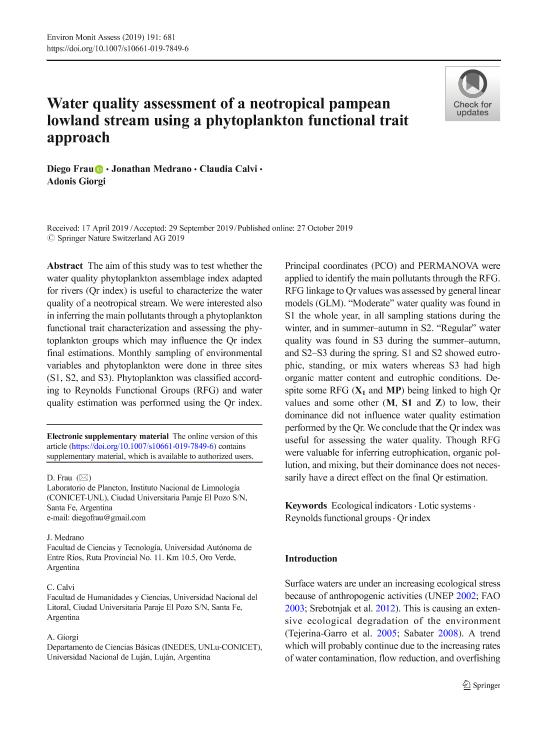Mostrar el registro sencillo del ítem
dc.contributor.author
Frau, Diego

dc.contributor.author
Medrano, Jonathan Jesús

dc.contributor.author
Calvi, Claudia
dc.contributor.author
Giorgi, Adonis David Nazareno

dc.date.available
2021-09-13T18:05:19Z
dc.date.issued
2019-10-27
dc.identifier.citation
Frau, Diego; Medrano, Jonathan Jesús; Calvi, Claudia; Giorgi, Adonis David Nazareno; Water quality assessment of a neotropical pampean lowland stream using a phytoplankton functional trait approach; Springer; Environmental Monitoring and Assessment; 191; 11; 27-10-2019; 1-14
dc.identifier.issn
0167-6369
dc.identifier.uri
http://hdl.handle.net/11336/140227
dc.description.abstract
The aim of this study was to test whether the water quality phytoplankton assemblage index adapted for rivers (Qr index) is useful to characterize the water quality of a neotropical stream. We were interested also in inferring the main pollutants through a phytoplankton functional trait characterization and assessing the phytoplankton groups which may influence the Qr index final estimations. Monthly sampling of environmental variables and phytoplankton were done in three sites (S1, S2, and S3). Phytoplankton was classified according to Reynolds Functional Groups (RFG) and water quality estimation was performed using the Qr index. Principal coordinates (PCO) and PERMANOVA were applied to identify the main pollutants through the RFG. RFG linkage to Qr values was assessed by general linear models (GLM). “Moderate” water quality was found in S1 the whole year, in all sampling stations during the winter, and in summer–autumn in S2. “Regular” water quality was found in S3 during the summer–autumn, and S2–S3 during the spring. S1 and S2 showed eutrophic, standing, or mix waters whereas S3 had high organic matter content and eutrophic conditions. Despite some RFG (X1 and MP) being linked to high Qr values and some other (M, S1 and Z) to low, their dominance did not influence water quality estimation performed by the Qr. We conclude that the Qr index was useful for assessing the water quality. Though RFG were valuable for inferring eutrophication, organic pollution, and mixing, but their dominance does not necessarily have a direct effect on the final Qr estimation.
dc.format
application/pdf
dc.language.iso
eng
dc.publisher
Springer

dc.rights
info:eu-repo/semantics/openAccess
dc.rights.uri
https://creativecommons.org/licenses/by-nc-sa/2.5/ar/
dc.subject
ECOLOGICAL INDICATORS
dc.subject
LOTIC SYSTEMS
dc.subject
QR INDEX
dc.subject
REYNOLDS FUNCTIONAL GROUPS
dc.subject.classification
Otras Ciencias de la Tierra y relacionadas con el Medio Ambiente

dc.subject.classification
Ciencias de la Tierra y relacionadas con el Medio Ambiente

dc.subject.classification
CIENCIAS NATURALES Y EXACTAS

dc.title
Water quality assessment of a neotropical pampean lowland stream using a phytoplankton functional trait approach
dc.type
info:eu-repo/semantics/article
dc.type
info:ar-repo/semantics/artículo
dc.type
info:eu-repo/semantics/publishedVersion
dc.date.updated
2020-04-24T17:47:10Z
dc.identifier.eissn
1573-2959
dc.journal.volume
191
dc.journal.number
11
dc.journal.pagination
1-14
dc.journal.pais
Alemania

dc.description.fil
Fil: Frau, Diego. Consejo Nacional de Investigaciones Científicas y Técnicas. Centro Científico Tecnológico Conicet - Santa Fe. Instituto Nacional de Limnología. Universidad Nacional del Litoral. Instituto Nacional de Limnología; Argentina
dc.description.fil
Fil: Medrano, Jonathan Jesús. Universidad Autónoma de Entre Ríos. Facultad de Ciencia y Tecnología; Argentina
dc.description.fil
Fil: Calvi, Claudia. Universidad Nacional del Litoral. Facultad de Humanidades y Ciencias; Argentina
dc.description.fil
Fil: Giorgi, Adonis David Nazareno. Consejo Nacional de Investigaciones Científicas y Técnicas. Oficina de Coordinación Administrativa Parque Centenario. Universidad Nacional de Luján. Instituto de Ecología y Desarrollo Sustentable; Argentina
dc.journal.title
Environmental Monitoring and Assessment

dc.relation.alternativeid
info:eu-repo/semantics/altIdentifier/doi/http://dx.doi.org/10.1007/s10661-019-7849-6
dc.relation.alternativeid
info:eu-repo/semantics/altIdentifier/url/https://link.springer.com/article/10.1007%2Fs10661-019-7849-6
Archivos asociados
